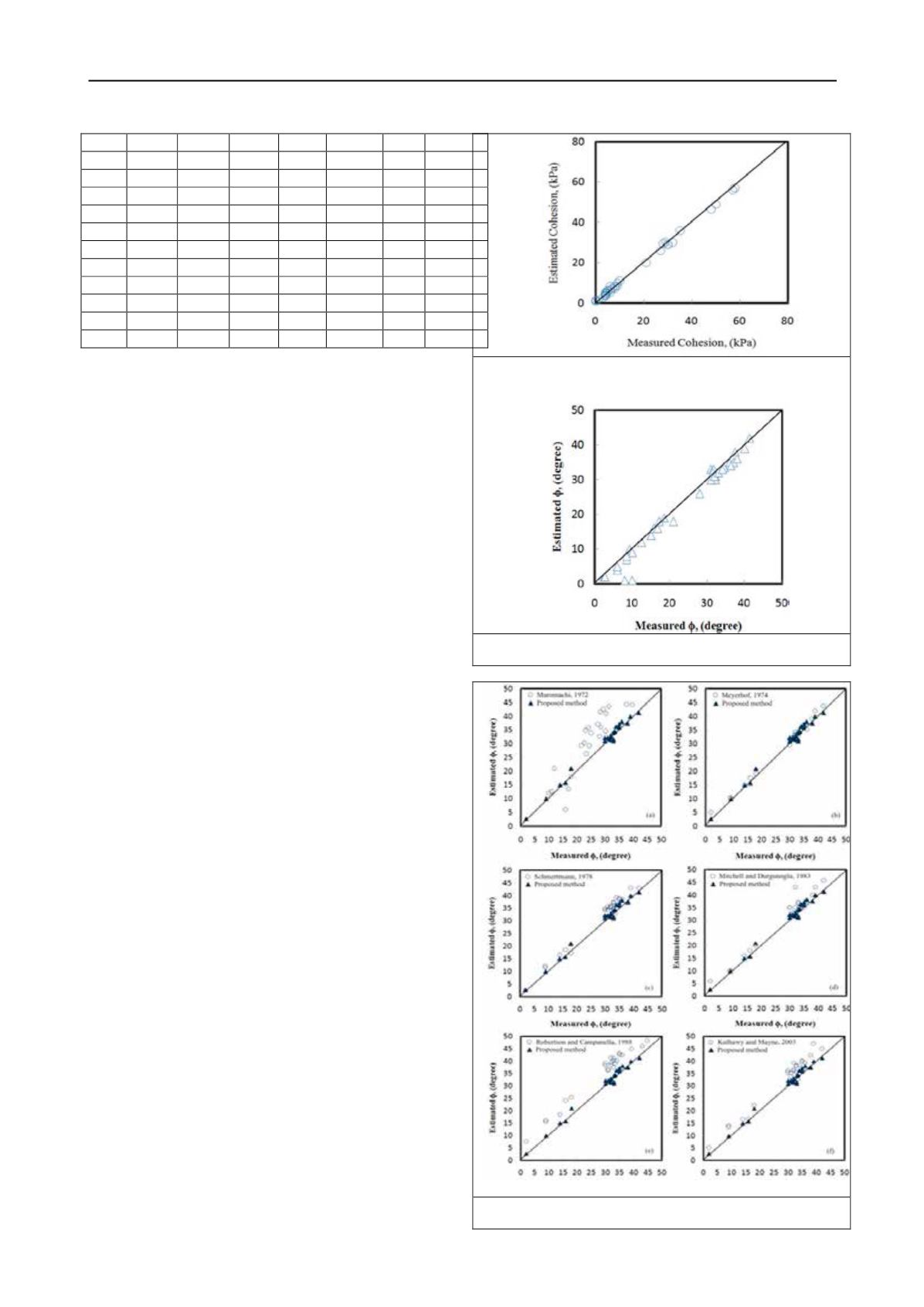
593
Technical Committee 102 /
Comité technique 102
ᴨ
CL
4
70
29
30
2
2.5
ᴨ
SM
4
90
58
57
2
2.7
Ш
CL
2
14
30
29
12
12
Ш
ML
2
55
28
29
14
15
Ш
SM
2
27
5
6.1
16
16
Ш
CH
2
56
57
56
5
6
Ш
CL
2
78
35
36
8
9
IV
SM
1
6
0
1
33
34
IV
SM
7
30
0
1
36
38
IV
SM
8
60
0
1.5
32
33
IV
SM
6
38
1
1.5
-
8
IV
SM
9
75
9
8.4
-
10
5 VALIDATION OF RESULTS AND DISCUSIONS
The accomplished geotechnical study in each site has been upon
borehole excavations. The samples dependent on soil
stratification and from different depths are taken as distributed
and undistributed specimens. For determining the shear strength
parameters, direct shear, uniaxial and triaxial tests are done on
samples in laboratory. Meanwhile, because of high quality of
sampling in triaxial test and logicality of the test results in
laboratory, it can be more adequate. Four practical cases include
CPT and CPTu test results associated with laboratory test
results and SPT records are used for evaluating the proposed
analytical relations.
The measurement results by laboratory tests and also,
prediction by using analytical procedure, are presented in
Table 1. Evaluation of results expressed the fact that the
suggested procedures not only can spontaneously predict and
determine both shear strength parameters but also it contain
acceptable and reasonable results. Fig. 2 is associated to
evaluation and comparison between laboratory results and
suggested analytical model for determining the cohesion
parameter. The measured and predicted C values show good
agreement which denotes the capability of analytical approach.
Also, Fig. 3 shows the comparison between measured values
and analytical procedure results for internal friction angle within
the range of study in four sites. As for the laboratory results
which are achieved from drained triaxial test and suggested
analytical model, it is observed that the proposed analytical
procedures based on CPT and CPTu in cases with cohesion and
internal friction angle, almost has identical to laboratory results.
The laboratory results are compared with different presented
procedures by researchers are shown in Fig. 4a to 4f. According
to graphs, the achieved friction angle values by other procedures
are always greater than the suggested analytical procedure
values and laboratory results. Meanwhile, it is observed that the
friction angle values from Meyerhof, (1974) results are closer to
bisector line indicating close agreement between the predicted
and measured values. Moreover, the presented analytical
procedure and laboratory results have more coincidence and are
closer to actual values. While, the values obtained from current
methods, are more than the experimental results and analytical
method.
The current procedures do not contain any recommendation
for soil cohesion and it is one of the advantages for the proposed
procedure. Also, it is not depending only one of the test outputs
rather, the entire CPT and CPTu outputs such as q
c
, f
s
and u are
used in equations, hence the error creation reaches to minimum
value in inaccurate records, because of the simultaneous
employment of each three output quantities, the other
advantages in the presented analytical procedure contrary to
traditional procedures. Furthermore, the shear strength
parameters derived from actual subsurface failure mechanisms
condition in cone tip and sleeve has been realized reasonably in
proposed relations.
Fig. 2. Comparison between the measured cohesion in laboratory and
estimated cohesion by proposed method
Fig. 3. Comparison between estimated and measured values for friction
angle
Fig. 4. Comparison between estimated and measured values for friction
angle


